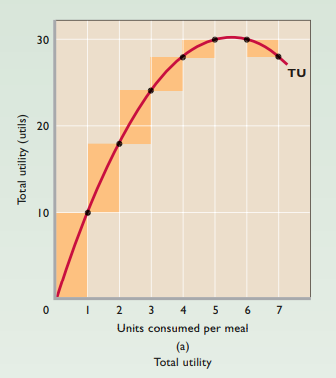Chapter 7: Consumer Behavior
Law of diminishing marginal utility - Added satisfaction declines as a consumer acquires additional units of a given product

Utility - Want-satisfying power
- Not the same as usefulness
- Subjective - The utility of a product differs b/w people
- Difficult to quantify (but measured w/ utils)
Total utility - Total amount of satisfaction/pleasure a person derives from consuming some specific quantity
Marginal utility - Extra satisfaction gained from an additional unit
Law of diminishing marginal utility explains why the demand curve for a product slopes downward
- Consumer will only buy additional units of a product if its price falls
Theory of consumer behavior
- Rational behavior - Consumers are rational people who use income to derive the greatest amount of utility
- Preferences - Consumers have clear-cut preferences for available goods
- Budget constraint - Consumers have a fixed, limited amount of money income
- Prices - Every good carries a price tag
Utility-maximizing rule - To maximize satisfaction, the consumer should allocate his or her money income so that the last dollar spent on each product yields the same amount of extra (marginal) utility
Consumer equilibrium - When the consumer has balanced their margins and has no incentive to alter their spending pattern
Consumer decision-making process
- Buy more of the good that provides more marginal utility per dollar
- Must choose a combination within the constraints of a consumer’s income
- Can obtain other combinations, but none will be as good as the one that provides the most total utility
Utility-maximizing rule
- Marginal utility of product A / Price of A = Marginal utility of product B / Price of B
- Equation not fulfilled → Reallocation of consumer expenditures will increase total utility
Utility maximization + the demand curve
- Product price + quantity demanded are inversely related
- Income effect - Impact that a change in the price of a product has on a consumer’s real income and the quantity demanded
- Substitution effect - Impact that a change in a product’s price has on its relative expensiveness and the quantity demanded
- Substitute purchases towards goods that yield greater utility in order to restore consumer equilibrium